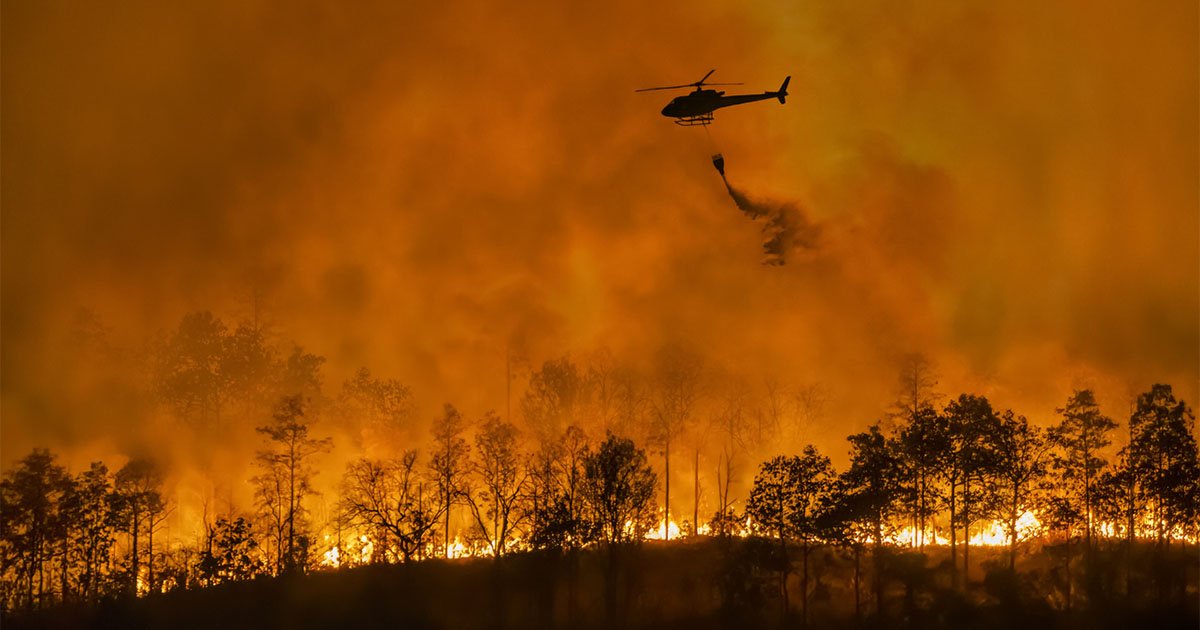Wildfires have become increasingly common across Canada and Minnesota during the summer months, bringing smoke and poor air quality across the state.
Jesse Berman, PhD, with the University of Minnesota School of Public Health, and Alec Duffy, MD, with the Medical School, discuss the health impacts of wildfire smoke, how people can protect themselves and future research on the topic.
Q: What are the short-term and long-term health effects of exposure to wildfire smoke?
Dr. Duffy: There are many ways that wildfire smoke exposure affects our health. Short-term effects include increased risk of asthma attacks and Chronic Obstructive Pulmonary Disease (COPD) flare-ups, which leads to increased use of rescue medications, emergency department visits and hospitalization; increased risk of respiratory infections, including pneumonia, influenza and COVID-19; and increased risk of cardiac events, including heart failure, heart attacks and strokes. Some studies show an association between wildfire exposure and adverse pregnancy outcomes, including low birth weight and preterm labor. Additionally, during wildfire events, there is an increased rise in all-cause mortality — or the total count of deaths during a specific time by any cause. These effects tend to be more pronounced in vulnerable populations, such as children, older adults and individuals with chronic health conditions.

Long-term effects are not as well established, though studies show that exposure is associated with decreased lung capacity. There is also growing concern about the cumulative effects of repeated smoke exposure over time.
Q: How is climate change expected to affect wildfire smoke exposure in Minnesota?
Dr. Berman: Climate change will substantially impact wildfires across North America, including a high potential to make them hotter, larger and more frequent, as well as lengthen the traditional wildfire season and expand wildfire risk zones. Drought conditions and hotter temperatures set the stage by drying vegetation, which can jumpstart the ignition of wildfires and make them harder to put out. Warmer winters are another risk factor for wildfires, which in Minnesota may mean a reduced snowpack that melts earlier in the year. It is also critical to know that while some wildfire smoke in Minnesota originates locally, we are frequently impacted by wildfire events from hundreds (or thousands) of miles away. The Upper Great Plains is in the pathway of smoke originating from central Canada that travels large distances before being pushed to ground-level. Some studies have also shown that this kind of wildfire smoke that travels long distances may be more toxic to human health.
Q: What can people do to protect themselves from exposure to wildfire smoke?
Dr. Duffy: It’s important to follow local air quality alerts. You can stay informed by using weather apps, the Minnesota Department of Health website or the EPA app AirNow.

During a wildfire smoke event, stay indoors as much as possible and keep your windows closed. If you have central air, turn it on, as the system’s air filter can help improve indoor air quality. Portable HEPA air purifiers can also be effective. When driving, keep your windows closed and set the air to recirculate. Reduce sources of indoor air pollution by avoiding smoking, using a wood-burning stove, frying or grilling food or vacuuming. If you must go outside, use a disposable respirator rated N95 or higher.
Those at higher risk should talk to their doctor about a wildfire plan, have 7–10 days of medications on-hand and stock up on food that doesn’t need cooking. Watch for symptoms like shortness of breath, chest pain, dizziness or worsening chronic conditions, and seek care if needed. If you care for others, consider checking in on older adults, children or neighbors who may need extra support during smoke events.
Q: Are certain communities or individuals more vulnerable to wildfire smoke than others?
Dr. Berman: Wildfire smoke is an environmental pollutant that impacts large regions, making it a true population-level hazard. Traveling to a nearby town or county won’t allow you to avoid smoke exposure, so everyone should be aware of wildfire smoke risks. However, some individuals may be more vulnerable to wildfire smoke events, including older adults, young children, pregnant mothers and those with certain pre-existing diseases such as asthma or COPD. These individuals should avoid being outdoors during heavy smoke periods, especially if it involves physical activity. Other at-risk individuals include workers whose jobs take them outdoors, which makes avoiding wildfire smoke more challenging. For these groups it is best to eliminate heavy exertion when possible or consider the use of an N-95 mask or respirator during the smokiest of conditions. Taking frequent breaks (preferably indoors) and being aware of your body’s limits is also critical.
Q: What are the gaps in our understanding of wildfire smoke and public health that you hope to address in your future research?
Dr. Berman: One area of research I’m particularly interested in are the health effects from “compound extreme weather events,” which are co-occurring (or simultaneous) extreme environmental conditions. For example, wildfire smoke during a heatwave or wildfire smoke in addition to a drought would be considered compound events. Compound events have the potential to worsen and escalate human health consequences beyond what we expect for individual conditions. Our bodies can experience physiological stress during a wildfire smoke event, but when they experience a heatwave at the same time, the stressors on the cardiovascular and respiratory system may be magnified. If health risks from compound events are found to be substantially greater than single events, it may be critical for public health warning systems to consider joint exposures when issuing alerts. Unfortunately, with climate change likely to increase the occurrence of compound events, I anticipate it will be a topic of growing importance.
Jesse Berman, PhD, is an associate professor in the University of Minnesota School of Public Health. He is an environmental epidemiologist, whose research investigates the relationship between human health and complex environmental exposures. He has a particular interest in evaluating how extreme weather, air pollution and climate influence population-level health.
Alec Duffy, MD, is an assistant professor in the University of Minnesota Medical School and an internal medicine and pediatric hospitalist with M Health Fairview. His clinical interests include care for the hospitalized patient, point of care ultrasound, and the health effects of climate.
-30-
About the School of Public Health
The University of Minnesota School of Public Health improves the health and wellbeing of populations and communities around the world by bringing innovative research, learning, and concrete actions to today’s biggest health challenges. We prepare some of the most influential leaders in the field, and partner with health departments, communities, and policymakers to advance health equity for all. Learn more at sph.umn.edu.
About the University of Minnesota Medical School
The University of Minnesota Medical School is at the forefront of learning and discovery, transforming medical care and educating the next generation of physicians. Our graduates and faculty produce high-impact biomedical research and advance the practice of medicine. We acknowledge that the U of M Medical School is located on traditional, ancestral and contemporary lands of the Dakota and the Ojibwe, and scores of other Indigenous people, and we affirm our commitment to tribal communities and their sovereignty as we seek to improve and strengthen our relations with tribal nations. Learn more at med.umn.edu.
About “Talking…with University of Minnesota”
“Talking…with University of Minnesota” is a resource whereby University of Minnesota experts answer questions on timely topics. Feel free to republish this content. If you would like to schedule an interview or have suggestions for future topics, please contact University Public Relations at unews@umn.edu.

